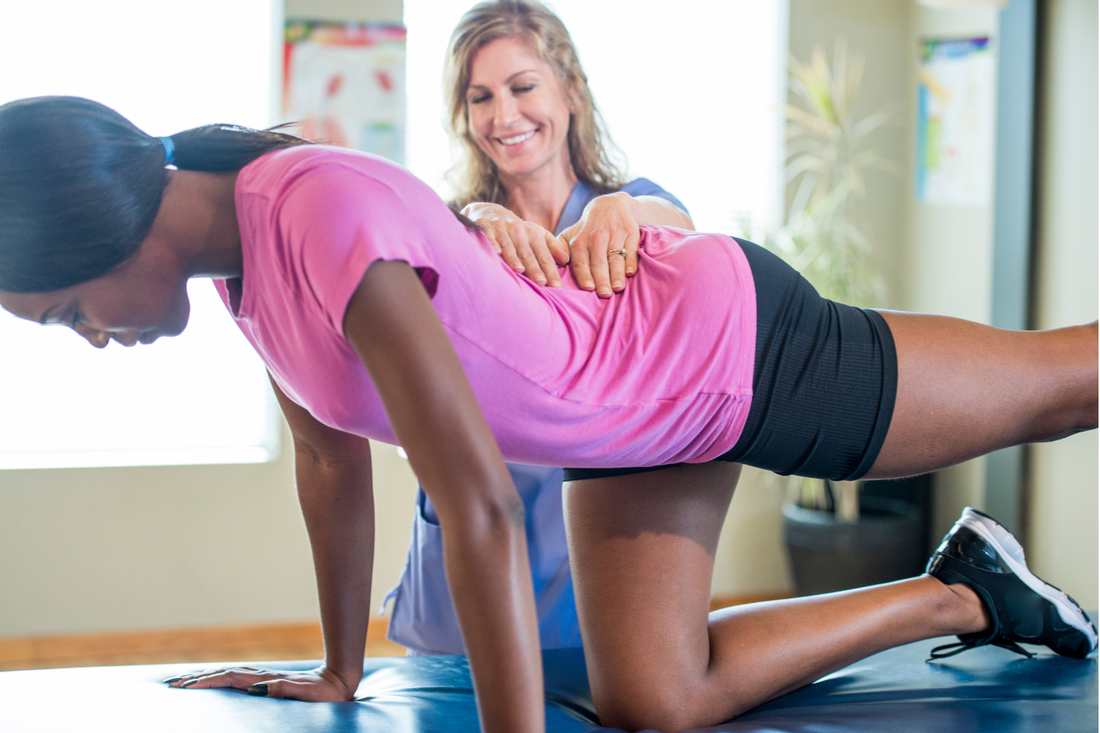|
Pelvic floor physical therapy (PFPT) is a type of physical therapy that focuses on treating dysfunction in the pelvic floor muscles. This form of therapy can be used to treat issues such as urinary or bowel incontinence, chronic pelvic pain, and interstitial cystitis. It can also help with postpartum recovery and sexual dysfunction. In this article, we’ll explore what pelvic floor physical therapy is, how it works and why it may be beneficial for some patients. What Is Pelvic Floor Physical Therapy?Pelvic floor physical therapy is a specialized form of physical therapy designed to address muscle dysfunctions in the lower abdomen and pelvis. It involves manual treatments, such as deep tissue massage, stretching exercises and electrical stimulation of the affected area. Through these treatments, therapists strive to improve muscle strength and flexibility, decrease tension in the muscles and reduce pain. How Does Pelvic Floor Physical Therapy Work?During PFPT sessions, your therapist will assess the condition of your pelvic floor muscles and focus on identifying imbalances or tightness in the muscles that are contributing to your symptoms. This can include examining your posture, range of motion and alignment. Your therapist may also use special imaging tests like ultrasound or electromyography to evaluate muscular activity within the area. Based on the findings from this assessment process, your therapist will then design an individualized plan of care that best suits your needs and goals. This plan could involve various manual treatments such as trigger point release or myofascial release techniques; electrical stimulation; muscle strengthening exercises; relaxation techniques; or other modalities like yoga or meditation therapies. As you progress through treatment, you’ll be monitored closely so your therapist can make any necessary adjustments along the way. Benefits Of Pelvic Floor Physical TherapyThere are several potential benefits to pelvic floor physical therapy:
Who Should Consider Pelvic Floor Physical Therapy?If you’re experiencing any pelvic discomfort or symptoms related to urinary incontinence or bowel problems (both common during pregnancy), then it may be worth considering PFPT as an option for relief. Additionally, those suffering from chronic pelvic pain syndromes like endometriosis could potentially benefit from PFPT if they’re experiencing difficulty with basic activities due to stiffness/weakness in their lower abdominal region resulting from these disorders. Ultimately it's up to you and your doctor/therapist team whether or not PFPT would be suitable for your situation - but it's definitely something worth discussing!
2 Comments
Are Sit Ups Bad For You? The Truth About This Core Sit ups, the classic core workout beloved by millions – but are they worth it? We can all agree that sit-ups are popular amongst those looking to strengthen their cores. But is this traditional exercise potentially causing harm while helping your muscles get stronger? In this blog post we'll explore both sides of the debate around sit ups and provide alternatives for an informed decision! Are Sit Ups Bad?While sit ups might be seen as an efficient way to strengthen and tone your abs, the reality is that sit ups can actually cause more harm than good. Doing sit ups incorrectly puts unnecessary strain on the back muscles, which can lead to aches and pains that could have been easily avoided. If you have a lumbar spine injury, such as a disc injury, sit ups can exacerbate those symptoms. Disc pressure is increased when you move into flexion at the lower spine. Furthermore, sit ups mainly focus on strengthening the rectus abdominus (the front six-pack muscle), without accounting for other core muscles located deep in our bodies' centers. While sit ups do target this famous muscle group, failing to exercise your entire core will leave you with a weaker body overall. Instead of relying solely on sit ups for abdominal strength, create a fitness plan that focuses on strengthening your entire core - sit ups are just one combination of exercises you should include! Core Strength Alternatives Want to get power and stability in your core? Planks and pallof exercises are the right kind of moves for you! These will target all muscles, not just those on front side; strengthen a range of abs & back regions plus focus down onto lower back & obliques. Make sure proper form is executed with correct breathing techniques - don't forget cardio-based activities like biking or running too as these will help build that strong body foundation everyone desires! Pallof PressTo do a pallof press correctly, physical therapists recommend standing with feet hip-distance apart and gripping the resistance band firmly in both hands. Hold your arms extended and parallel to the floor, making sure the band is at chest level. Engage your deep core before turning laterally away from the anchor point while securely holding onto both ends of the band. You should feel resistance throughout your trunk when you turn to create tension on the band. Keep your hips facing forward so you don’t compromise form. Once you are in position, attempt to press outward against the resistant band by engaging through your abdominals as you slowly walk both arms away from each other. Don't round or arch your back too much. Try to maintain a neutral position. Feel free to step around yourself as necessary while maintaining tension on the resistance band until you complete 8-12 reps with each side. This exercise will help strengthen and stabilize your core muscles over time! PlanksPlanking is a great way to strengthen your core muscle group and perfect your posture! To perform this exercise, draw in the navel area, keeping arms straight and forearms aligned with shoulders. Activate thigh muscles by engaging them for maximum effect - allowing for neutral spine alignment. Aim to hold yourself in this position for 30-45 seconds or longer as you progress – being sure not go too low or arch at any point during each rep! With proper form you can enjoy all of planking's powerful benefits.. Happy Plankin' ! Dead Bug
Hip Flexor Strengthening To Support Your CoreStrengthening your hip flexors is important for overall bodily health. Hip flexors are made up of a set of muscles that contract when you bring your legs in toward your chest and stabilize the hip joint during movement. Strengthening these muscles through exercises such as leg raises or using resistance bands can help with balance, agility, posture, and core stability. Additionally, this strengthening can help decrease pain in the lower back when done consistently and properly. With stronger hip flexors, you can provide lasting support to your entire body and guard against injury throughout your life. Hip flexor strengthening can be a great alternative to the sit up because it will work similar muscles and train your body to be able to maintain neutral spine position during movement. If you’re looking for a way to improve your core strength, sit-ups may not be the best option. There are many other exercises that can help you achieve this goal, such as pallof press, hip flexor strengthening, planks, and dead bugs. To learn more about these exercises and how they can benefit you, call MiraSol Physical Therapy today to schedule your evaluation. We can help you create a personalized exercise program that will help you build a strong and healthy core. Guest post written by HIDEF Physical Therapy
Women’s Health: Uncovering the Benefits of Physical TherapyDid you know that physical therapy can offer a host of benefits for women's health? pelvic floor physical therapy, in particular, can help with issues such as incontinence and pelvic pain. If you're looking for an effective treatment option that doesn't involve surgery or medication, then physical therapy may be the right choice for you. In this blog post, we will discuss the many benefits of pelvic floor physical therapy and how it can help improve your quality of life. What is pelvic floor physical therapy?Pelvic floor physical therapy is a type of physical therapy that focuses on the muscles and tissues of the pelvic floor. The pelvic floor is a group of muscles and tissues that support the organs in the pelvis, including the bladder, uterus, and rectum. These muscles and tissues can become weak or tight, which can lead to problems with urination, defecation, sexual function, and pain. Pelvic floor physical therapy can help to strengthen and stretch the muscles and tissues of the pelvic floor. This can help to improve urinary and fecal incontinence, as well as reduce pain. Pelvic floor physical therapy can also help to improve sexual function by increasing blood flow to the pelvic region and providing guidance on how to correctly perform Kegel exercises. How does pelvic floor physical therapy help with incontinence and pelvic pain?Pelvic floor physical therapy is a form of therapy that helps to strengthen the muscles in the pelvic floor. This can help to improve incontinence and pelvic pain. The pelvic floor muscles support the bladder and help to control urination. When these muscles are weak, it can lead to incontinence and pelvic pain. Pelvic floor physical therapy can help to strengthen these muscles and improve symptoms. What are the other benefits of pelvic floor physical therapy?Pelvic floor physical therapy can offer a number of benefits beyond just pain relief. For example, pelvic floor physical therapy can help to improve bladder control and reduce incontinence. Additionally, pelvic floor physical therapy can also help to improve sexual function and reduce sexual dysfunction. And lastly, pelvic floor physical therapy can also help to improve overall quality of life. So, if you’re experiencing any type of pelvic pain, or if you’re simply looking to improve your overall quality of life, consider seeking out a pelvic floor physical therapist near you. How can pelvic floor physical therapy improve your quality of life?Pelvic floor physical therapy is a specialized form of physical therapy that can help improve the quality of life for people with a variety of pelvic floor disorders. The pelvic floor is a group of muscles and tissues that support the bladder, uterus, and rectum. These muscles and tissues can become weak or damaged due to pregnancy, childbirth, aging, surgery, or other conditions. This can lead to problems such as incontinence, pelvic pain, sexual dysfunction, and more. Pelvic floor physical therapy can help to strengthen and tone the muscles and tissues of the pelvic floor. This can improve symptoms such as incontinence, pelvic pain, and sexual dysfunction. Pelvic floor physical therapy can also help to improve quality of life by helping people to regain confidence and improve their overall wellbeing. Why is pelvic floor physical therapy an effective treatment option? Pelvic floor physical therapy (PT) is an effective treatment option for a variety of pelvic floor disorders. The pelvic floor is a group of muscles, ligaments, and tissues that support the pelvic organs and span the bottom of the pelvis. These muscles and tissues can become weak or tight, and can be injured or stressed, leading to a variety of conditions such as incontinence, pelvic pain, sexual dysfunction, and more. Pelvic floor PT can help to improve muscle tone and strength, increase range of motion, decrease pain, and improve overall function. PT can also help to address the underlying causes of pelvic floor disorders, such as pregnancy or childbirth, surgery, menopause, or chronic health conditions. Pelvic floor PT is typically done with the help of a physical therapist who is specially trained in this area. Treatment may include manual therapy techniques, exercises, electrical stimulation, and/or education on how to care for the pelvic floor. Pelvic floor PT is an effective treatment option for many people with pelvic floor disorders. It can help to improve symptoms and quality of life. If you think you may benefit from pelvic floor PT, talk to your doctor or healthcare provider about a referral to a qualified physical therapist. |
AuthorMiraSol Physical Therapy ArchivesCategories |
Proudly powered by Weebly

 RSS Feed
RSS Feed 



